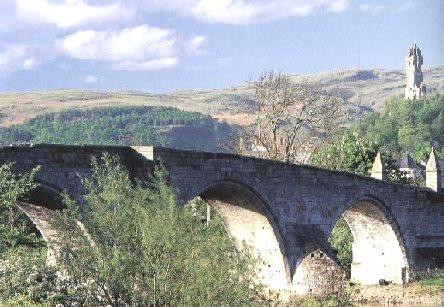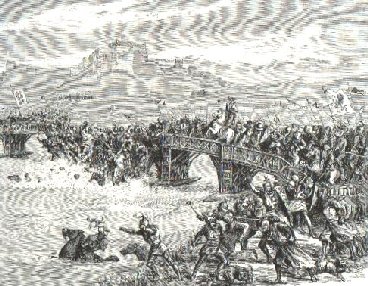The
Battle of Stirling Bridge
 |
|
With his army swollen to 40,000
lightly armed foot soldiers and about 180 horses, Wallace
took up the postion on the steep sided high ground now
known as Abbey Craig, looking across the Forth to
Stirling and its vital castle. His men, who would have
made the most of their own weapons, used 12ft long
spears, axes and knives and wore rough hide tunics or
homespun cloth; few would have had helmets or any form of
body armour. The English
Governor of Scotland, John de Warenne, Earl of Surrey,
commanded a force of mail-clad cavalry, skilled longbow
men from Wales and well- weaponed infantry, in all
numbering 60,000, with 8000 in reserve.
|
Wallace
monument on the Abbey Craig, Stirling.
|
|
|
This was to be Wallace's first
experience of a standing battle as against guerilla and harrying
actions.
| If Warenne, with his stronger
and more disciplined force, could engage Wallace's men he
would achieve a decisive victory, and, by killing or
capturing Wallace, end all opposition to Edward. But he
had a problem. The Forth lay between him and his
objective, and there was just one narrow wooden bridge
across it. He rejected the suggestion of using a ford
frther upstream, which would have caught the enemy in
thre rear, on the grounds that it would divide his army;
it is more likely that he suspected treachery. While he
hesitated, Hugh de Cressingham, Edward's Treasurer of
Scotland, protested against 'the waste of the king's
money, in keeping up an army, if it was not to fight'. |
|
 |
| |
|
The Stirling
Bridge today, thought to be very close to where the
original stood.
|
With that prod and the encouragement of
his men, many of them seasoned veterans of Flanders and Wales,
Warenne ordered that the infantry should start crossing the
bridge at dawn the following day, 11th September 1297. He flat
ground beyond the brudge was marshy, and any attack would have to
be made along a causeway and then uphill. From Abbey Craig,
Wallace had a perfect view of the thin file of English fanning
out from the bridge to pick their way hesitantly over the
treacherous ground while his force lay in hiding at the foot of
the Ochil Hills on their flank. It was the perfect situiation for
an ambush, with Wallace able to dictate the terms on which he
would fight.
 |
|
At the critical moment he gave
the order and the Scots charged down the slopes to reach
the bridgehead and trap a manageble number of the enemy
who perished intheir thousands, caught between the
Scottish spears and the river. What cavalry had crossed
the bridge was son floundering in the boggy ground, and
those fighting to get back over it were blocked by those
still advancing. Only one, Sir Marmaduke de Twenge,
succeeded; he spurrd his horse through the press at the
bridge, no doubt killing and injuring many of them. His
reward from Warenne was the order to assemble whatever
forces he coud muster and occupy the now doomed Stirling
Castle. Warenne himself then mounted his horse and rode
forthe safety of Berwick. Cressngham, who had an odious
reputation even among the English and had been
particularly barbaic in oppressing the Scots, was killed
in the battle. |
The Scottish losses at Stirling Bridge were relatively light, but
the great loss to Wallace was the death of his faithful friend
and joint general Sir Andrew Moray. This victory, followed by a
string of successes, including the surrender of Edinburgh Castle,
quickly restored Wallace to the favour of the vacillating
Scottish nobles. Campaigning in Flanders, Edward receieved the
news that ' this leader of a little band of outlaws, this plebian
without family, influebce or wealth, supported by merit alone,
had wrenched from the English every fortress in Scotland'.
back to History index
HOME
This
page created on 17th April, 2000


